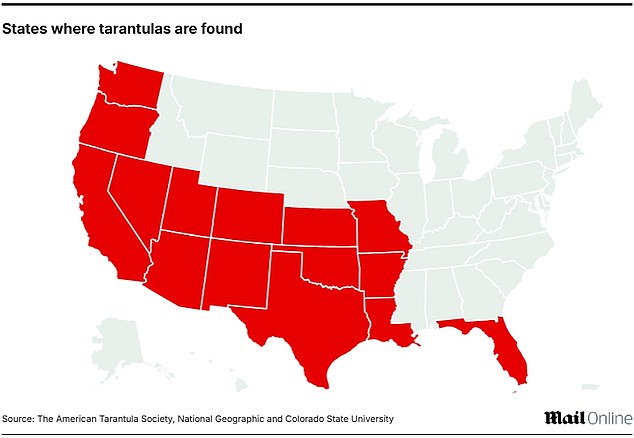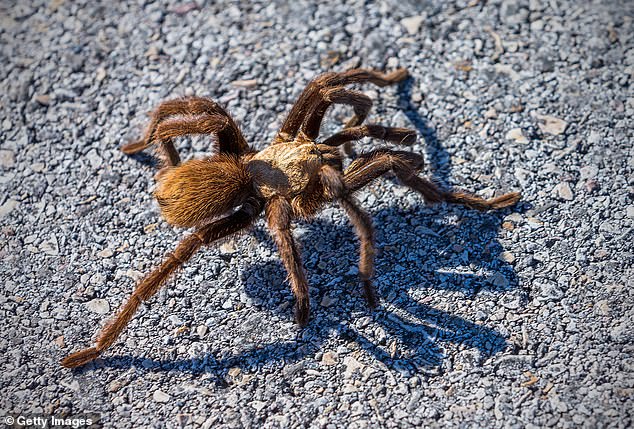Thousands of giant tarantulas are set to emerge from the ground in five states starting next month.
Wildlife officials warned the hordes will appear in parts of California, Colorado, Kansas, New Mexico and Texas from August through October.
The softball-sized spiders, while mostly harmless to humans, can still bite, flick irritating hairs, or cause alarm as they wander through campsites, backyards, and across roads.
Residents and visitors may spot the spiders crossing roads in groups or creeping across campsites and backyards.
In some places, tarantulas are expected to appear by the dozens, marching in loose lines across roads like tiny brown tanks.
Unlike most desert animals that avoid heat by hiding, these tarantulas come out when the late-summer rains begin.
The sudden rise in moisture and shift in temperature signal it is time to find a mate.
Dan McCamish, a senior environmental scientist with California State Parks, said: ‘They’re typically out from late evening into early dawn, that’s when visitors tend to see them.’

There are 29 different tarantula species in the US. Texas alone is home to at least 14 of them
There are 29 different tarantula species in the US. Texas alone is home to at least 14 of them.
The Austin American-Statesman reported that Texas is bracing for a full-blown mating season, with tarantulas popping up across South Texas grasslands and deserts.
In Colorado, the town of La Junta actively encourages people to visit during mating season to observe the tarantulas.
La Junta Tourism said: ‘Ideal places to look for those males are south of La Junta on highways and county roads before sunset.’
‘Comanche National Grassland is a good place to spot them as well,’ they added.
The most commonly seen species is the Aphonopelma, also known as the Colorado Brown Tarantula, a dark brown to black spider.
In California’s Tri-Valley, tarantulas turn up in places like Mount Diablo State Park, Del Valle Regional Park and Sunol Regional Wilderness.
Moreover, in Kansas, sightings are most common in the south and west, especially around the Red Hills and the grasslands of Chautauqua and Elk counties.

Wildlife officials said the annual mass movement of tarantulas is expected to peak from now through October.
New Mexico is home to six different tarantula species, including the Texas brown, desert blonde (or Arizona blonde), Grand Canyon black tarantula, and a newly discovered species named Aphonopelma jacobsican.
They will be spotted along the Rio Grande Gorge, West Rim Road, and near Tres Piedras, with their range extending from Valencia County to Taos and Albuquerque.
Wildlife officials said the male spiders are the ones seen crawling across the roads, sometimes up to 20 miles, while the females stay close to their burrows, waiting to attract a male partner through their chemical scents known as pheromones.
Dr Lauren Davidson, a Texas-based entomologist and spider expert, said: ‘They’re just out looking for love, let them go find a girlfriend.
Female tarantulas live the longest, up to 25 years, while the male spiders live just for a few years and die just after mating. In some cases, the female spider eats the male tarantulas after their breeding, if she is hungry.
If fertilization is successful, the female lays up to 3,000 eggs in a sticky white sac, which she guards until the spiderlings hatch.
The spiders are venomous, but their bites are not deadly to humans. Experts said tarantulas can climb low trees and jump nearly two feet, but they are not aggressive and won’t attack unless provoked.
‘If it starts coming towards you, give it some space. It might be defending its eggs, or you might have interrupted a mating ritual between a male and female,’ McCamish said.
Touching a tarantula can also be painful because of the barbed hairs on its abdomen called urticating hairs.
McCamish said: ‘They can actually flick those hairs off their back feet like darts.’
‘If they get on your skin, or worse, in your eye, it can cause serious irritation,’ he warned.
Experts advise brushing the hair off with a towel, cloth, or even duct tape to prevent lingering irritation.
